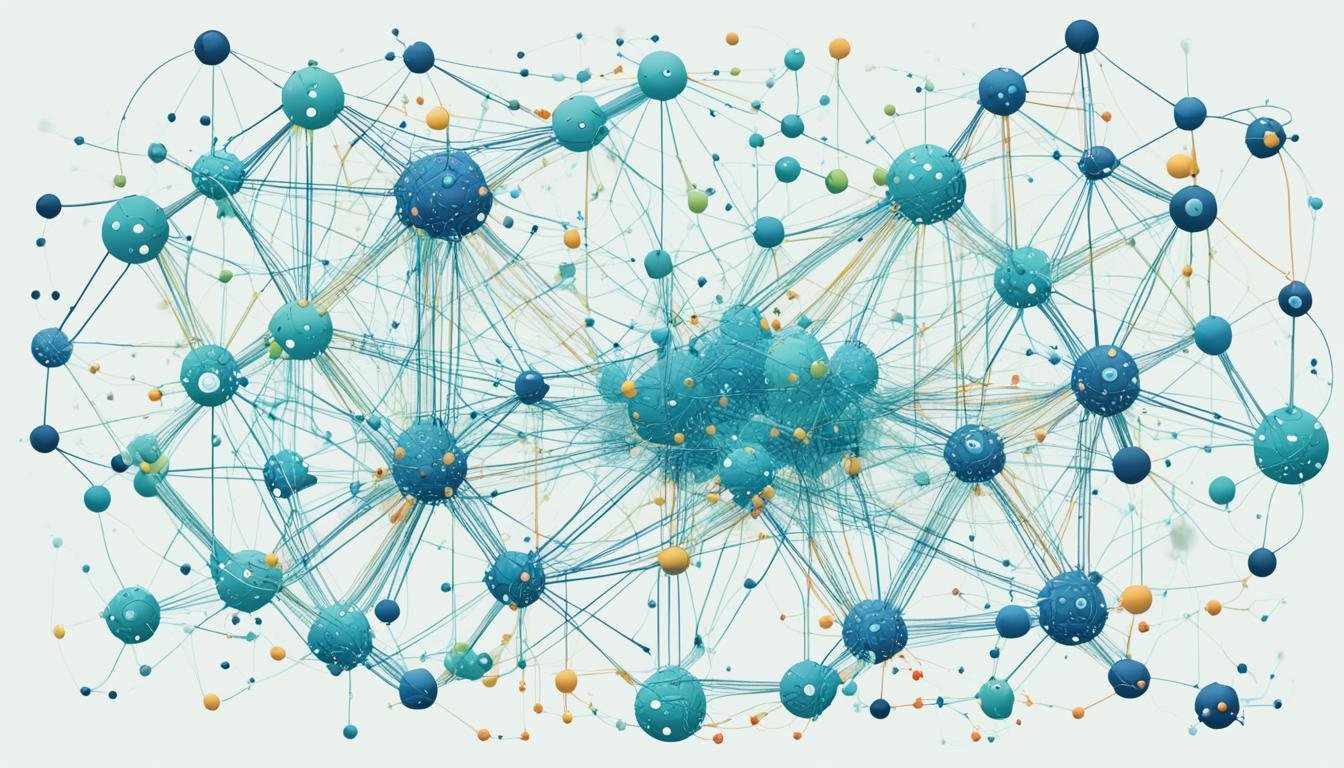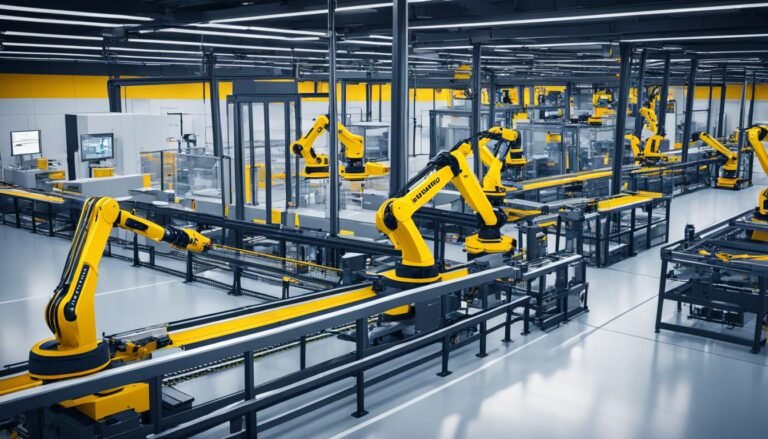Deep Learning Demystified: Understanding Neural Networks and Their Applications
Ever wonder how your computer knows your friends in photos or picks songs for you? The answer is deep learning. It’s a new field in artificial intelligence. It uses neural networks to do tasks that once only humans could do.
A neural network works like our brains. It’s made of layers of neurons that connect to process data. These networks easily spot patterns in huge amounts of information. This use across different fields like health and finance shows their power.
In the 1960s, people were first interested in neural networks. This interest faded but grew again in the 1980s and now. Thanks to powerful GPUs, we can now make deep learning networks with many layers. This has led to huge AI improvements.
Deep learning has changed the game, outpacing old machine learning. It’s now making predictive models and decisions better. In this article, we’ll cover neural networks’ basics, designs, and uses. You’ll see why they’re leading the AI revolution.
Key Takeaways
- Neural networks are computational models that mimic the human brain’s structure and function.
- The resurgence in neural network research was driven by advancements in GPUs and deep learning techniques.
- Modern neural networks consist of multiple layers, enabling complex data processing and decision-making.
- Deep learning is a pivotal component in today’s most effective AI systems.
- Understanding neural networks helps in grasping their transformative impact across various industries.
Introduction to Deep Learning and Neural Networks
Deep learning leads modern AI with networks that work like the human brain. These networks change how we use technology. We’ll look into what neural networks are and their vital role in AI.
What is Deep Learning?
Deep learning is a kind of machine learning. It uses networks with many layers to find patterns better. Thanks to powerful GPUs, deep learning has made things like talking to computers and understanding images much better.
It’s different from old ways because it can learn from a lot of data and make smart guesses.
The Evolution of Neural Networks
Neural networks started with simple parts in the 1950s and became more complex over time. Now, they can do a lot, depending on the task. For example, Convolutional Neural Networks are great for spotting patterns in images, while Recurrent Neural Networks work well with sequences, like language. By 2014, GANs were invented to create new kinds of data.
Today’s networks are much deeper and smarter than before. Some can have up to 50 layers.
Importance of Neural Networks in AI
Neural networks are key in AI. They help machines see, understand, and predict things. Their deep layers let them learn from data and solve hard problems. As AI gets better, neural networks will do a lot more and help in different areas.
Understanding Neural Network Basics
Neural networks are key in deep learning and have become very popular lately. They work by connecting many nodes, like our brain’s neurons, to process data. The interest in them has varied, but now, new developments have placed them in the AI spotlight.
These networks are organized in layers. They start with input layers, then move through hidden layers, before finally giving results in output layers. This setup allows the network to understand information step by step. The hidden layers play a key role by using complex methods to refine the network’s predictions.
Training is the backbone of how neural networks work. During training, networks tweak their internal settings to make better guesses. This tweaking ensures they get better at their tasks over time. The introduction of the Perceptron in 1957 was a big step. It was the first example of a network that could train itself, opening the door to today’s advanced models.
The 1980s saw a big jump in training efficiency thanks to new algorithms. Back then, this progress renewed people’s interest in neural networks. But, it was the GPU technology that really made complex networks possible. This made neural networks shine in areas like identifying images and understanding speech.
Learning about the core of neural networks and their intricate data processing gives us a glimpse into the advanced AI we see today. By understanding their foundations, we can see where the future of this technology is heading.
Architecture of Neural Networks
The design of neural networks is both complex and intriguing, setting the stage for their incredible abilities. These networks can have thousands, even millions, of nodes that are linked together. They are arranged in layers to process information in a specific order.
Input, Hidden, and Output Layers
A neural network has three main types of layers: input, hidden, and output. Data first goes into the input layer. Then, the hidden layers, which can be many, perform detailed calculations. They find important features in the data using many neurons.
The final layer gives the network’s answer or classification. Through this multi-step process, neural networks can understand complex data patterns.
Feedforward and Deep Neural Networks
Feedforward networks are the most basic. They send information in a single direction, from input to output. Though useful, their power is limited when handling really complex tasks.
Deep neural networks, on the other hand, have extra hidden layers. This lets them grasp much more intricate and abstract patterns in data. They are great for handling large amounts of data and solving tough problems.
With modern technology, these networks have been able to grow in size. They also tackle more difficult issues like overfitting. This progress with deep neural networks shows how the field of artificial intelligence is always advancing.
Common Activation Functions in Neural Networks
Activation functions are key in computer vision and language processing. They let neural networks tackle complex patterns. By adding non-linearity, they help deep learning handle intricate data representations well.
The Sigmoid or logistic activation is known for its perfect 0 to 1 output. This is great for models that predict probabilities. Its formula is f(x) = 1 / (1 + e-x). But, it has a problem known as the vanishing gradient issue for values outside of -3 to 3. This can make the training of neural networks harder, making the output asymmetrical around zero.
The Tanh function overcomes this issue by ranging from -1 to 1. This helps center data around zero. Its formula is tanh(x) = (ex – e-x) / (ex + e-x). Despite facing vanishing gradient problems similar to the sigmoid, its data centering ability is a plus in certain neural network uses.
The ReLU has quickly become a favorite due to its simplicity and effectiveness. It sets negative inputs to zero and increases linearly for positives, f(x) = max(0, x). This solves the vanishing gradient problem well in deep networks. But, the dying ReLU issue might occur, where some neurons stop responding because their inputs are always zero during training.
To fix ReLU’s issues, the Leaky ReLU came about. It allows a small, non-zero gradient for negative values. Its formula is f(x) = x if x > 0 else αx (α is a small constant). This step helps in keeping the neurons useful, which can boost the model’s learning abilities.
Finally, the Exponential Linear Unit (ELU) improves upon ReLU by offering a continuous gradient for all inputs. This leads to quicker learning and likely better accuracy. The ELU formula is f(x) = x if x > 0 else α(ex – 1). Its smooth curve with negative values makes ELU a top choice for both language and vision tasks, supporting effective network learning.
Training Neural Networks: Methods and Processes
Training a neural network well is key to building accurate predictive models. The process has many steps to make the network work better. We’ll focus on two important parts: Backpropagation and Optimization Algorithms.
Backpropagation
In the 1980s, machine learning got a major boost with Backpropagation. This technique looks at the input data and the network’s output. Then, it checks the results against what we expected. It figures out the mistakes and corrects them by updating the network’s weights and thresholds. Over and over, it learns to make better predictions based on the input data.
Optimization Algorithms
Backpropagation isn’t the only important part. Optimization algorithms like Gradient Descent, Adam, and RMSprop are also crucial. They make sure the network learns more effectively by adjusting its parameters. This way, the network gets better at predicting and isn’t as likely to make mistakes. Thanks to these predictive modeling methods, researchers can overcome big issues like overfitting and too much complexity. They help make neural networks strong and useful for many different things.
Applications of Neural Networks Across Industries
Neural networks use advanced AI to change how industries work. They are especially powerful in healthcare. For example, they help identify skin cancer better than human doctors do.
In self-driving cars, recurrent neural networks are key. They are great at predicting what will happen next on the road. This makes self-driving cars safer and more reliable.
Financial companies also find neural networks very helpful. They improve fraud detection, making it up to 95% accurate. This saves the institutions lots of money each year.
When it comes to recognizing images, CNNs are better than RNNs. They can identify pictures with up to 99.3% accuracy. Autoencoders are also great for data compression, being 45% more efficient than other networks.
Neural networks are not only for these industries. They’re used in farming, marketing, and entertainment. They even help produce special effects in movies. In agriculture, they help analyze crops and the weather. In marketing, they tailor ads to what people like.
In finance, neural networks help predict economic trends. They guide where to invest money. Social media platforms use them to customize what users see. They aim to make the experience better and keep people engaged.
In IT and data science, predictive analytics are key. Neural networks are used for this, as well as for classification and clustering. Deep learning powers applications like chatbots and self-driving cars. It’s changing the tech world.
To make neural networks work well, proper training is needed. Things like supervised learning and transfer learning are important. It shows how these technologies are complex but crucial across many areas.
Current Challenges and Future Trends in Neural Networks
Exploring the world of neural networks brings us to current hurdles and future prospects. An important challenge is that neural networks often make decisions without clear explanations. This mystery makes it hard for companies to fully rely on artificial intelligence.
Additionally, training AI for business uses a lot of power. Different computing tools like CPU, GPU, and FPGA vary in how well they work. This becomes even more critical as AI gets more intricate, requiring better hardware and smarter algorithms.
One major issue is with Recurrent Neural Networks (RNNs). RNNs are good at understanding sequences like in music and videos. But they have trouble with long dependencies, limiting their use.
To tackle this, LSTM and GRU networks have come into play. These new models improve on RNNs by allowing for better memory of long sequences. With their help, AI becomes more trustworthy in real-world applications.
In the Journal of Big Data, deep learning issues are hot topics with lots of people reading and discussing them. The goal is to make AI more open and easier to use. This means working to simplify neural networks, make them clearer, and decrease the need for huge computing power.
Conclusion
In the ever-changing world of artificial intelligence, deep learning and neural networks play a key role. They stand as a foundation for making big steps in many fields, like healthcare and recognizing images. Neural networks, like Convolutional and Recurrent Neural Networks, work well with complex information. They are great at making forecasts and spotting patterns.
Deep neural networks learn detailed data structures because they have many layers. This makes them very good at making accurate predictions. The more they train, the better they get. They fix mistakes and fine-tune to perform at their best.
Activation functions, such as the ReLU and sigmoid, are also very important. They add the ability to learn complex patterns to neural networks. This leads to better, more trustworthy predictions. The progress in artificial intelligence relies heavily on these achievements. This points to many new and exciting uses for these technologies in the future.
Source Links
- https://news.mit.edu/2017/explained-neural-networks-deep-learning-0414
- https://dev.to/vidhisareen/demystifying-deep-learning-a-beginners-guide-to-neural-networks-6e1
- https://www.aitrend.info/index.php/neural-networks-demystified/
- https://medium.com/@dbhatt245/a-gentle-introduction-to-deep-learning-and-neural-networks-778a6188e181
- https://medium.com/@mr_nair_007/demystifying-deep-learning-understanding-the-basics-of-neural-networks-abeae4665e66
- https://www.pluralsight.com/resources/blog/data/deep-learning-neural-networks-explained
- https://www.v7labs.com/blog/neural-network-architectures-guide
- https://medium.com/@zahmed333/what-is-the-new-neural-network-architecture-kan-kolmogorov-arnold-networks-explained-d2787b013ade
- https://towardsdatascience.com/activation-functions-neural-networks-1cbd9f8d91d6
- https://www.v7labs.com/blog/neural-networks-activation-functions
- https://medium.com/@bragadeeshs/neural-network-training-demystified-a-comprehensive-guide-to-mastering-deep-learning-15eb7a774962
- https://www.wgu.edu/blog/neural-networks-deep-learning-explained2003.html
- https://journalofbigdata.springeropen.com/articles/10.1186/s40537-021-00444-8
- https://medium.com/@rubentak/a-deep-dive-into-deep-learning-recurrent-neural-networks-f5f0e38ecfe8
- https://medium.com/@nitindubey709/demystifying-deep-learning-understanding-neural-networks-c27b0c42b0d0
- https://medium.com/@aisyndromeart/deep-learning-demystified-exploring-neural-networks-fd3b9df78d3a








